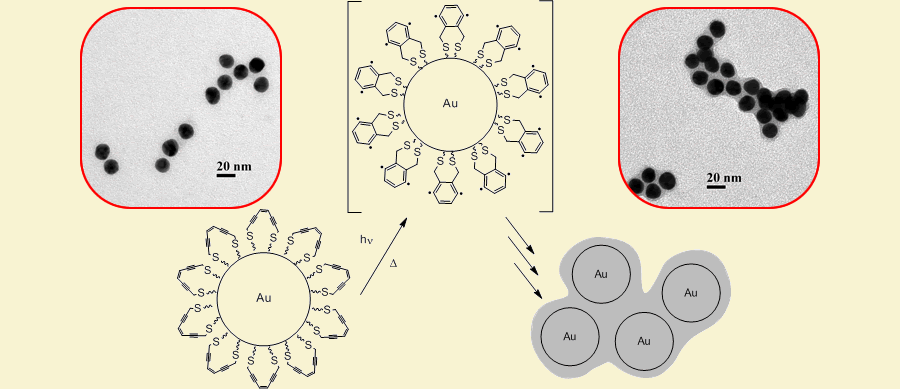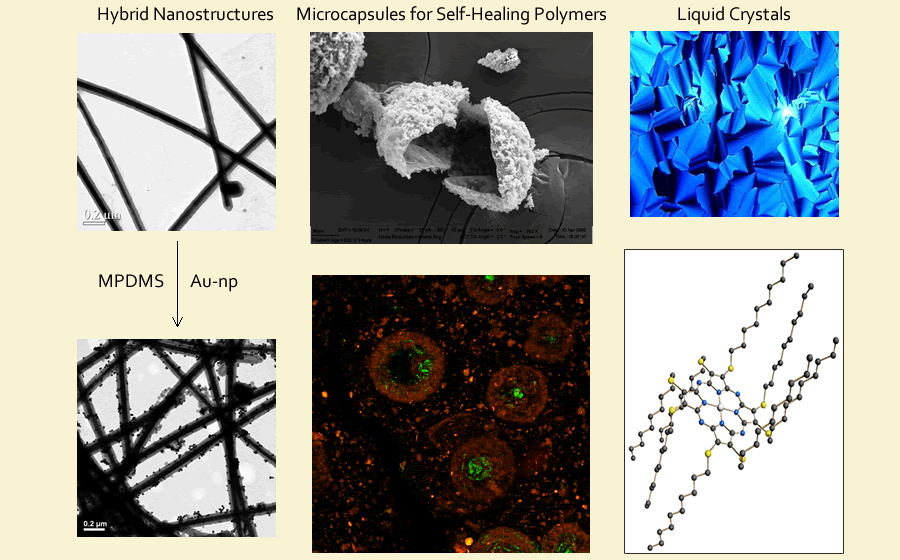Developing Hybrid Nanomaterials for Energy and Nanomedicine
The dramatic rise in interest in nanometer sized materials in recent years is due to the remarkable properties uniquely accessible at small sizes, where quantum effects become important. Both organic (polymer and carbon-based) and inorganic (pure metals, alloys, and metal oxides or sulfides) nanomaterials can show optical, magnetic, or conductivity properties unforeseen in the bulk material. In this vein, we are broadly interested in the development of novel nano-scale architectures as hybrid materials for optics, photo-magnetic switching, and nanomedicine applications. Constructing these materials involves the development of new synthetic strategies or novel ligand coatings with specific properties to enable optical or magnetic excitation.
In our most recent work, we have integrated enediyne functionalities into gold nanoparticle (Au-np) scaffolds and used the optical properties of the Au-np to trigger the reaction of the surface moiety. Surface plasmon excitation leads to cyclization of the enediyne and attendant radical generation at the particle perimeter. At high concentration in the absence of substrate, polymerization of the surface coating is observed.

Past work in the group has developed the syntheses of silver nanowires and assemblies of multifunctional metal, semiconductor, and quantum dot structures. Building upon this experience, we are currently investigating combining reactive enediyne molecules with hybrid nanostructures (Fe3O4-Au, Fe3O4@SiO2, etc.) as a way to bring additional functionality to biomedically-relevant nanomaterials. Such multifunctional nanoparticles can be used to target, image, and treat cancer cells. Our approach centers on harnessing the magnetic or optical properties to trigger a radical-generating reaction to create potent new treatment strategies.
In addition to our efforts in constructing functionalized nanoparticles for medical applications, we have ongoing interest in the development of nanotube (carbon and metallic) and nanofiber platforms for finely controlled conductivity and/or magnetic properties at the nanoscale. This is important in space applications, negative index of refraction materials, and nanosolar energy conversion devices. Complex, multi-component architectures can be constructed by surface functionalization of developed nanoscale building blocks and assembling those components into larger scale nano-microscale units. One can also generate hybrid nanoscale/polymeric materials that have self-healing capabilities, or magnetic properties by doping polymers with catalysts to repair radiation damage, or generate plastics that are magnetic. Finally, liquid crystals can loosely be considered a nanotube architecture that is transformable under thermal, photochemical, or pressure conditions. These columnar building blocks can also carry magnetic, optical, or conductivity characteristics that when summed over the length of the column can provide the potential for switching or bidirectional electronic communication.


